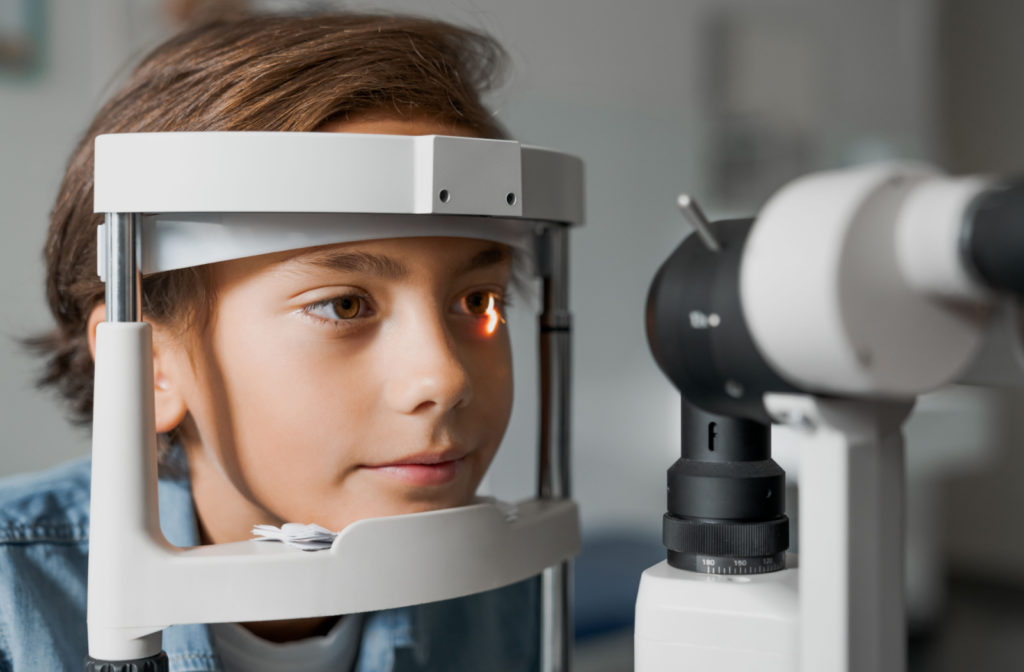Lazy eye, otherwise known as amblyopia, is a condition that affects approximately 3% of the children population of America. It occurs when the brain fails to recognize the images transmitted from one eye, leading to poor vision or loss of visual acuity in that eye.
Contrary to popular belief, lazy eye is not a result of eye damage but rather a problem with brain development.
It’s never too late to treat amblyopia. There’s a pretty common misunderstanding that only children can get treatment for this condition, but that’s not true at all. While the best results usually come from starting treatment before age 7, older kids and adults can still benefit from vision therapy.
Family Focus Eyecare has a strong emphasis on treating pediatric eye diseases, notably amblyopia. This condition won’t simply solve itself; the more it’s left untreated, the more difficult it becomes to manage. It’s important to get an eye exam and treatment as soon as possible!
Understanding the Causes of Lazy Eye
Lazy eye occurs when the brain and the eyes fail to work together properly. Lazy eye is generally caused by three things:
Strabismus
Strabismus, or crossed eyes, is when the eyes aren’t aligned right, which leads to what’s called strabismic amblyopia. The brain chooses to ignore the input from the misaligned eye to prevent double vision confusion in a young, developing brain. This can cause the ignored eye to lose visual sharpness as the brain favors the straight eye.
Refractive errors
This is when one eye has a lot more trouble focusing than the other, leading to refractive amblyopia. Even if a child’s eyes are perfectly aligned, they might be really nearsighted, farsighted, or have astigmatism in one eye, and not the other.
The brain then starts relying on the better eye and mostly ignores the other, which can lead to that eye being underused and developing amblyopia.
Obstruction of vision
Sometimes, something blocks light from getting into a child’s eye and prevents it from developing properly. Known as deprivation amblyopia, this can be caused by a cataract, a cloudy lens, a droopy eyelid, or a scar on the cornea.
Treatments for Lazy Eye
One common treatment is using an eyedrop medication called atropine which blurs the vision in the stronger eye. This treatment is often prescribed for use on weekends or daily depending on the case.
Another exciting new approach to treating lazy eye uses a virtual reality (VR) headset to help improve vision in children aged 4 to 7. The child watches videos wearing the VR headset as part of the treatment that adjust and train.
Another method is covering the stronger eye with a stick-on eye patch to encourage the use of the weaker eye.
Treatments can also include glasses or eye drops, and the specific treatment will depend on factors like the type and severity of the lazy eye.
Always remember, treatment is most effective when started at a young age. So, it’s crucial to get an early diagnosis!
Treating Lazy Eye in Adults
While it’s commonly believed that treatment for lazy eye is most effective in childhood, it’s never too late to start treating the condition, even as an adult.
Often, the treatment involves a combination of prescription lenses, vision therapy, and sometimes patching.
A study by the National Eye Institute (NEI) found that lazy eye can be successfully treated up to age 17. That’s promising news for anyone who has this condition and is past the “traditional” age for treatment.
Another strategy that’s sometimes used is laser refractive surgery. This can help improve mild or moderate amblyopia in both children and adults.
In general, it seems like there’s a lot of hope for adults with lazy eye. The most important thing is to get a diagnosis and start treatment as soon as possible.
The Importance of Regular Eye Exams
Regular eye exams are very important, especially when it comes to conditions like lazy eye. These exams aren’t just for people who already have vision problems, they’re vital for everyone, regardless of age or physical health, to maintain healthy eyes.
One of the key reasons for this is that regular eye exams can help spot eye diseases early, which is crucial for preserving your vision.

Final Thoughts on the Timeline for Treating Lazy Eye
Like any vision problem, lazy eye requires proactive treatment to improve one’s vision. While most treatments are effective in childhood, it’s never too late to take action.
Whether you’re a child or an adult, understanding the condition and its underlying causes is pivotal in making sure you receive the most effective treatment. Proper diagnosis and early treatment can greatly improve the chances of success, enhancing vision in the affected eye. That said, regular eye exams with your eye doctor at Family Focus Eyecare are pivotal in detecting vision-related problems at their early stages, making sure that one’s eyesight is preserved throughout their life. Book your next appointment today!



